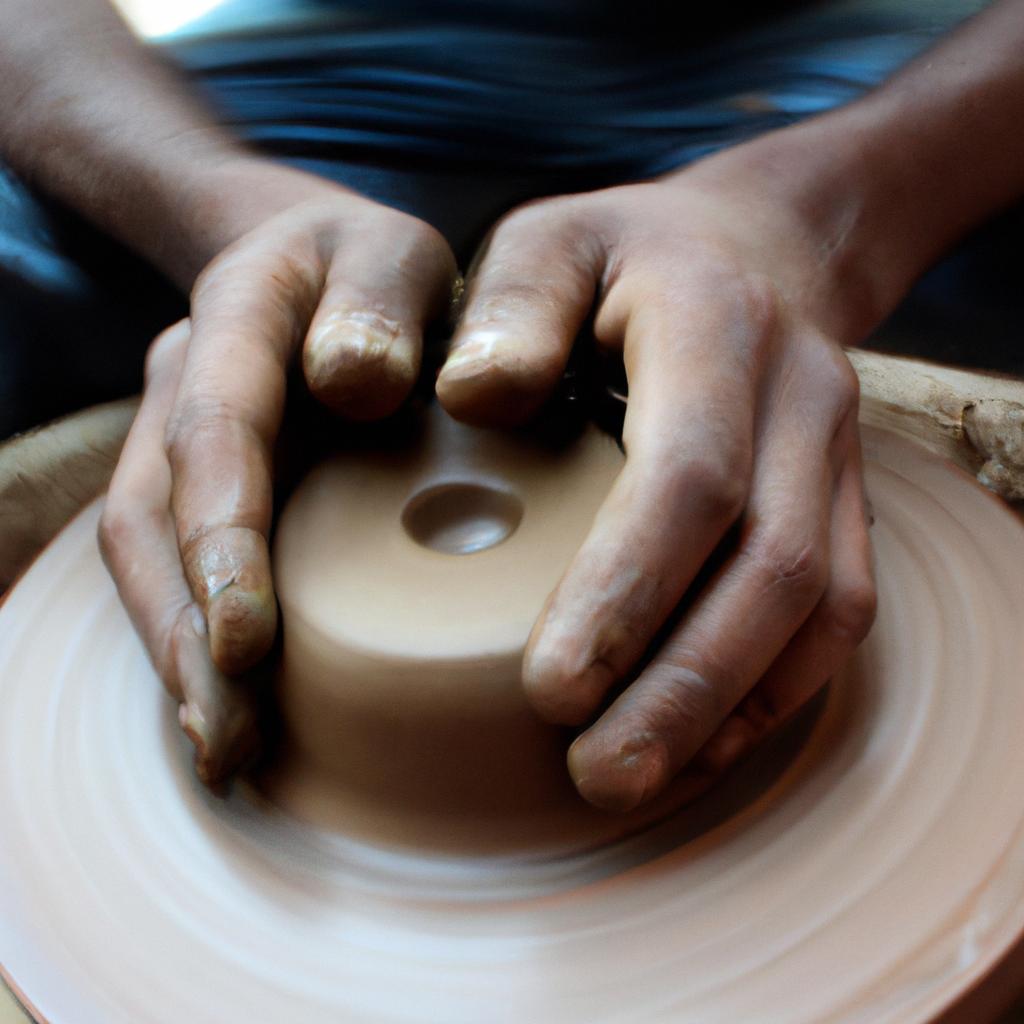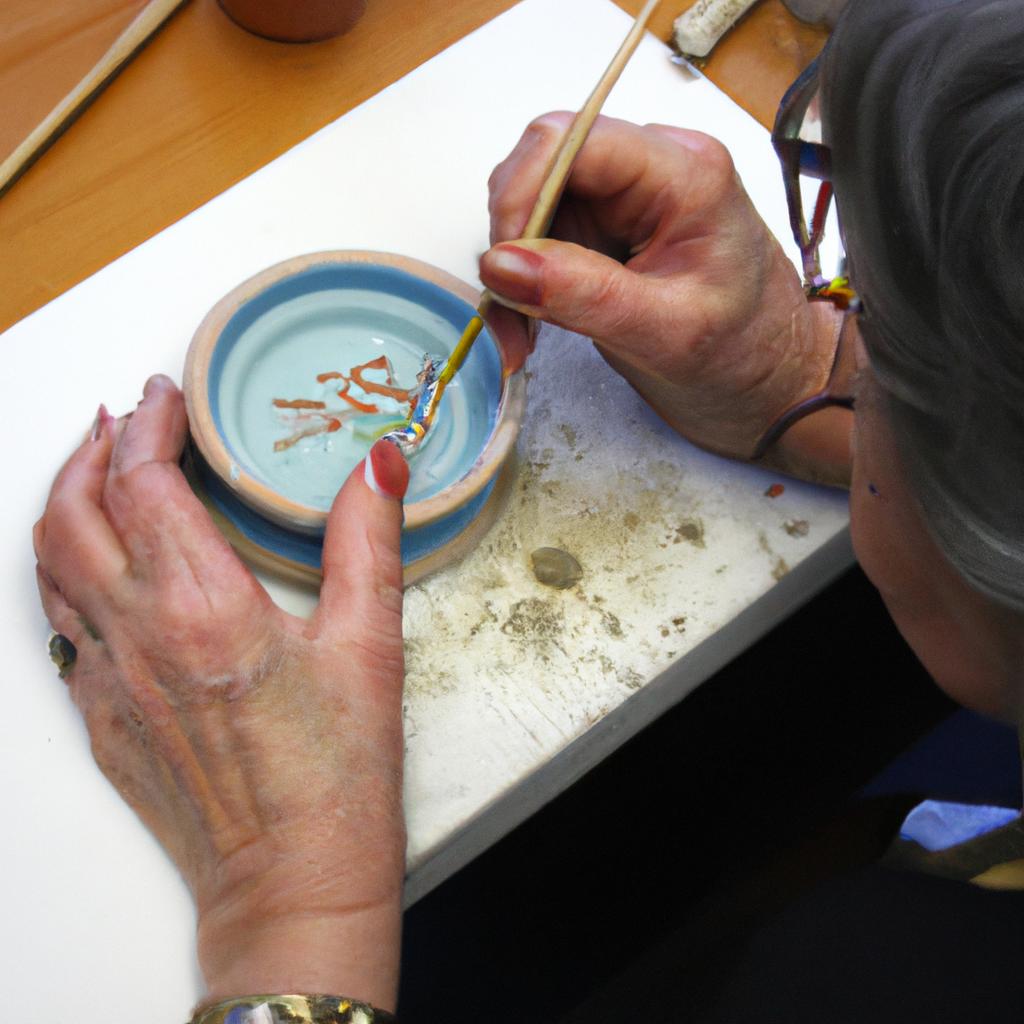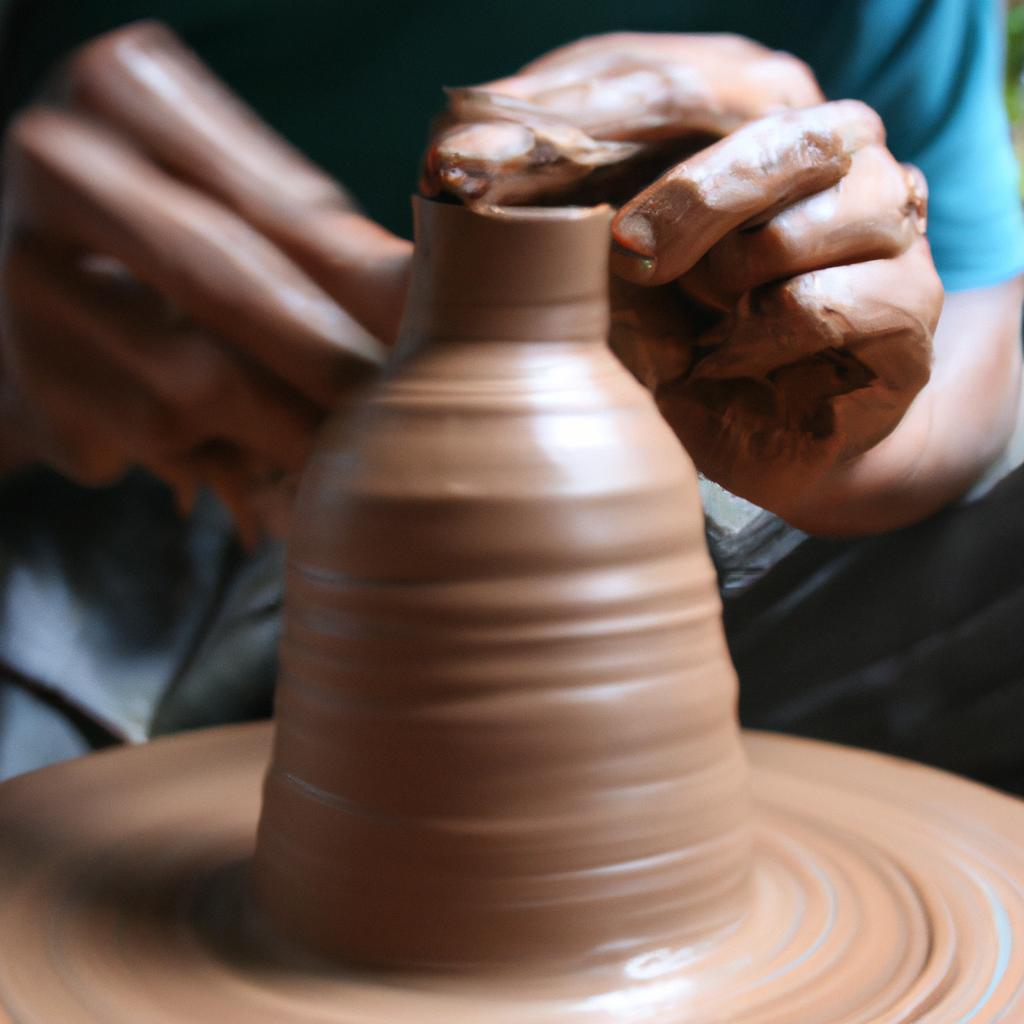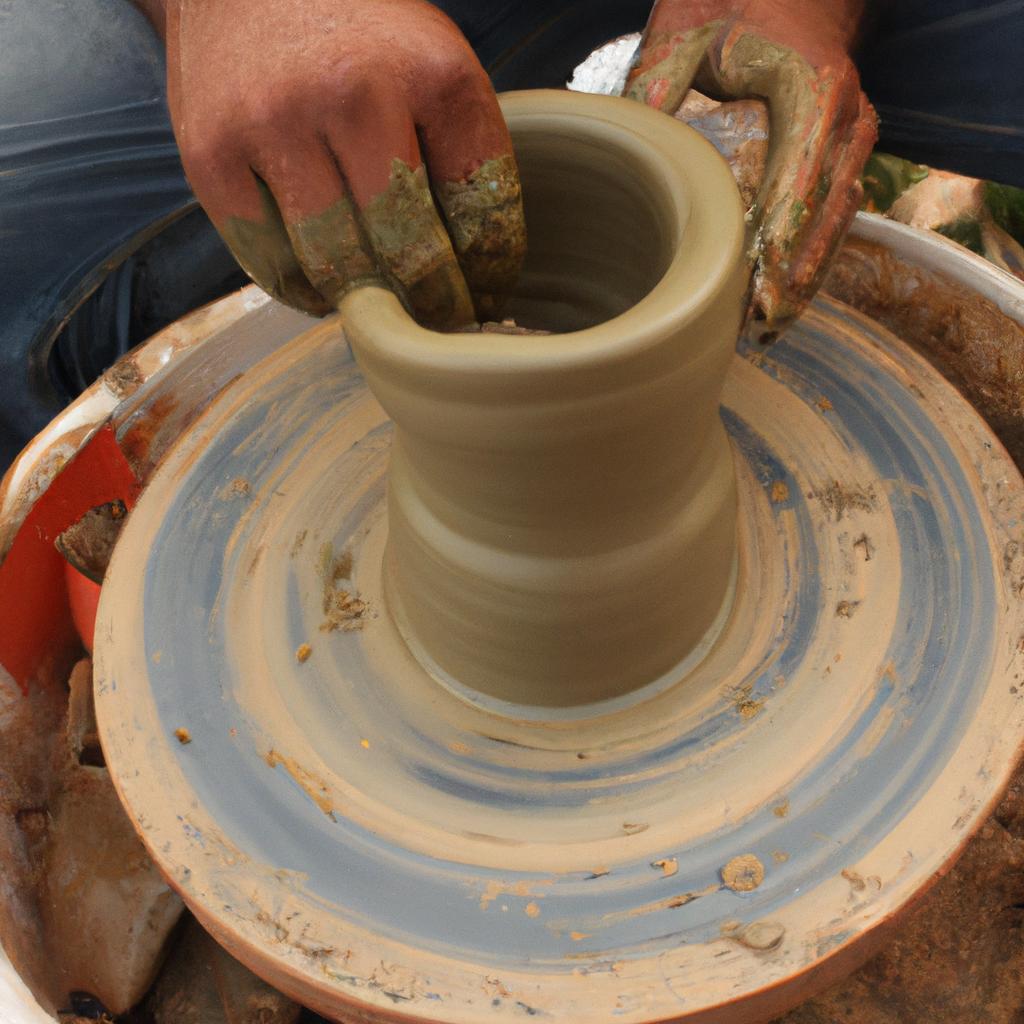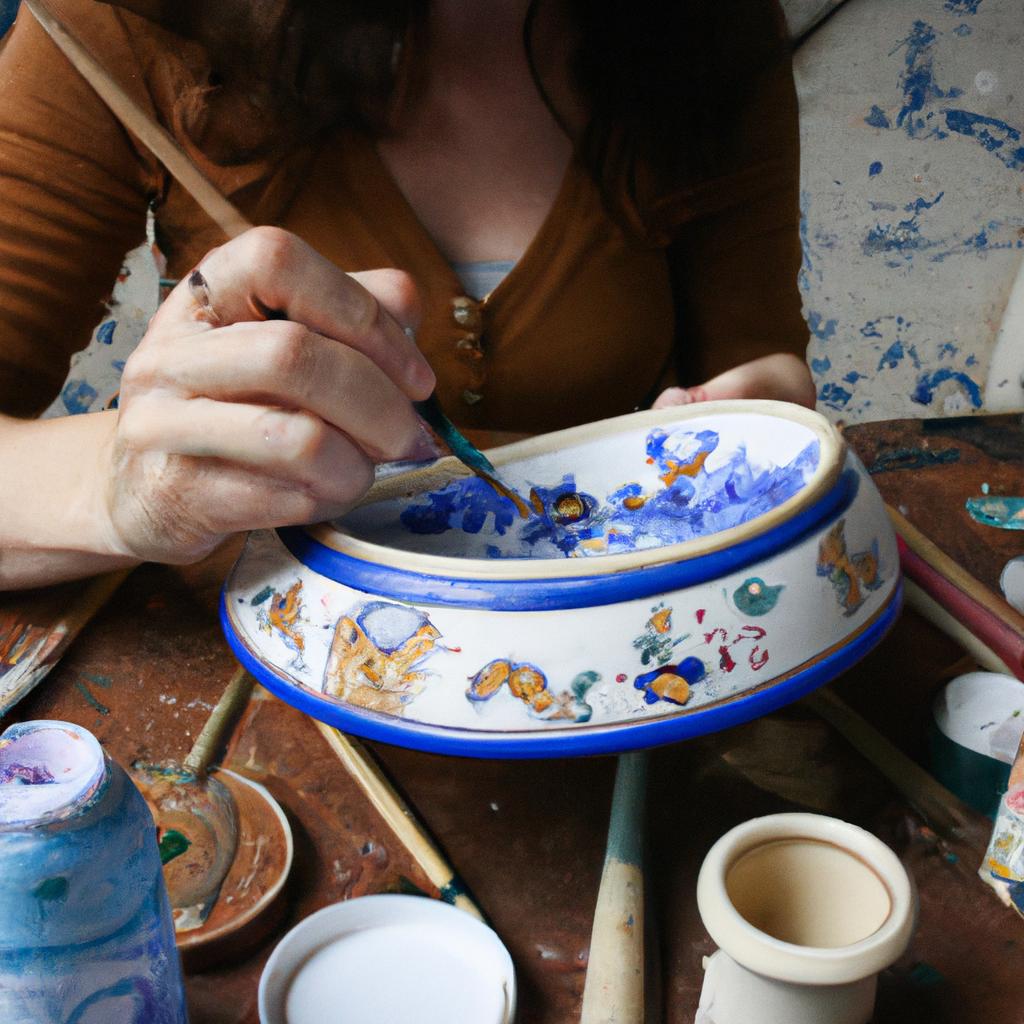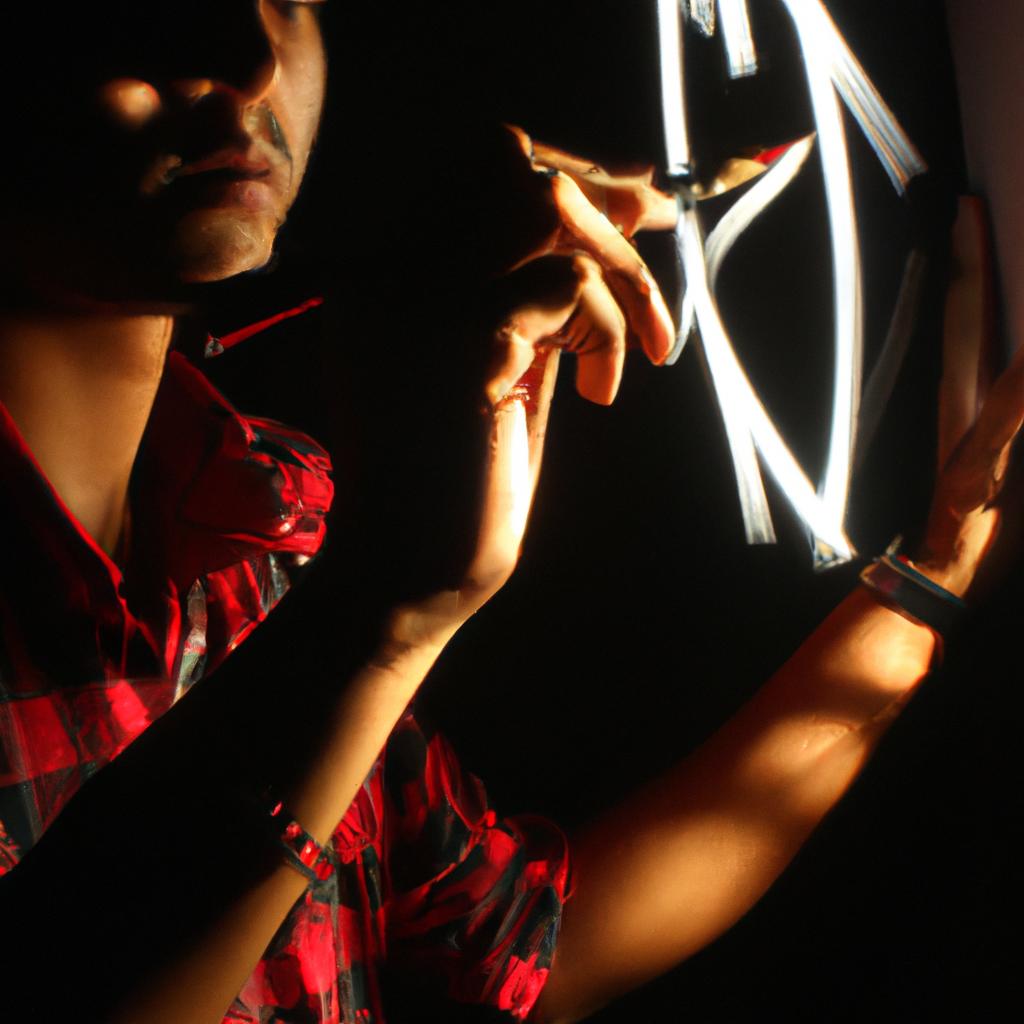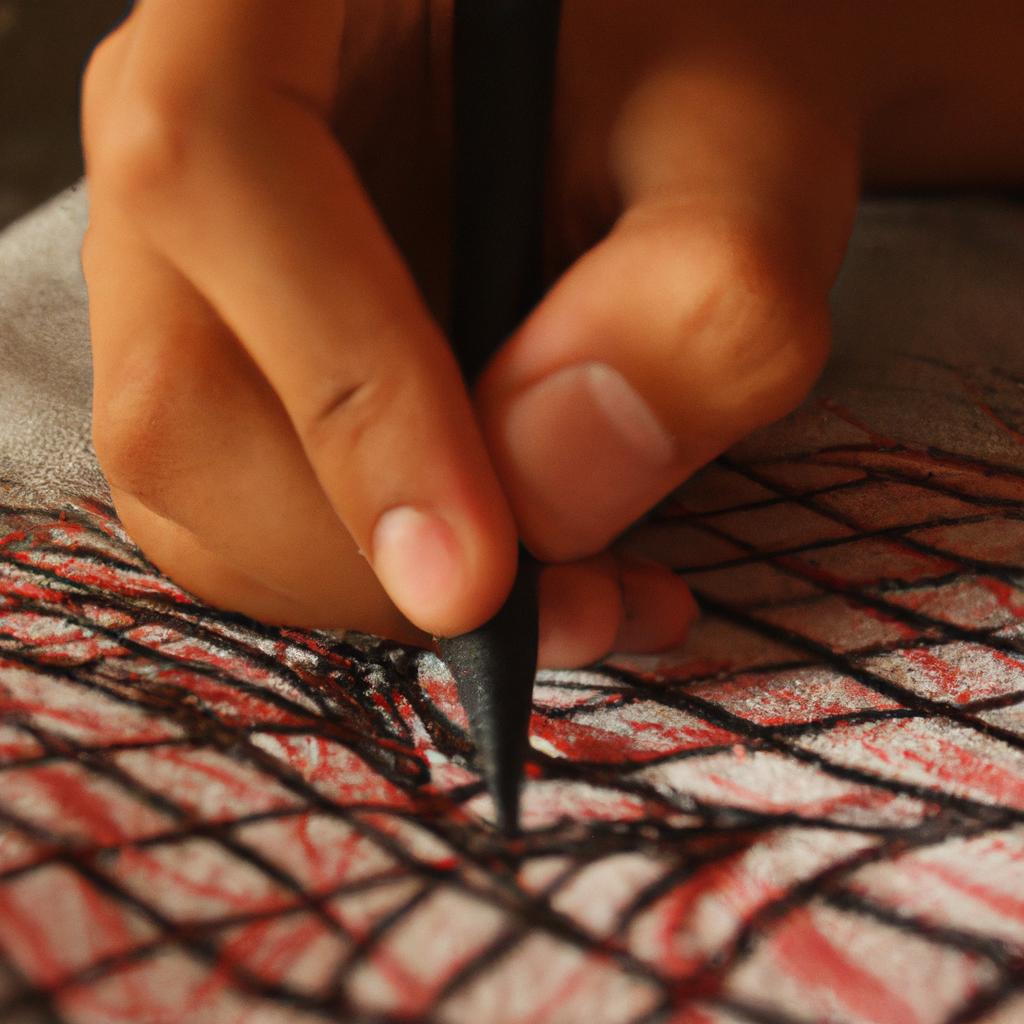Kiln Firing in Visual Arts: An Informative Guide on Ceramics
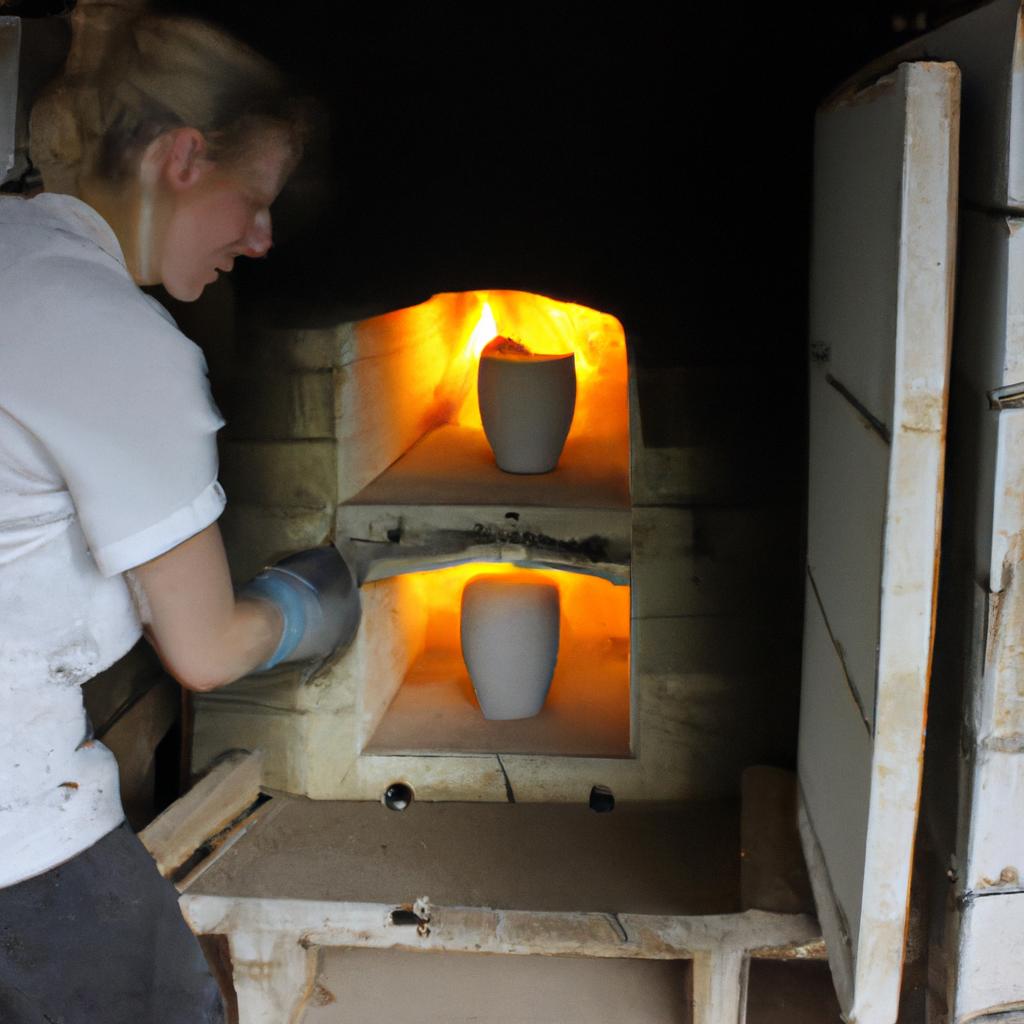
Kiln firing is an essential process in the creation of ceramics, as it transforms raw clay into durable and visually captivating artworks. This informative guide aims to provide a comprehensive overview of kiln firing in visual arts, exploring its various techniques, applications, and significance within the realm of ceramics. To illustrate the importance of this process, let us consider a hypothetical scenario: an aspiring ceramic artist named Sarah who embarks on her artistic journey by experimenting with different forms and glazes but finds herself puzzled when faced with the challenge of properly firing her pieces. By delving into the intricacies of kiln firing, this article seeks to demystify the process for artists like Sarah, enabling them to achieve optimal results and unlock their creative potential.
Understanding kiln firing entails comprehending its technical aspects and harnessing them effectively to produce high-quality ceramic works. The first section will explore key concepts such as temperature control, heating rates, and cooling methods that dictate the success or failure of a firing cycle. Additionally, we will delve into crucial considerations regarding kiln loading strategies, placement of artwork within the kiln chamber, and appropriate shelf materials to ensure even heat distribution throughout the firing process. Furthermore, this guide will shed light on various types of kilns commonly employed in ceramics, including electric kilns, gas kilns, and wood-fired kilns. Each type has its unique characteristics and requirements, which artists must understand to make informed decisions about their firing processes.
These include oxidation firing, reduction firing, and alternative atmospheric firings such as raku and saggar firing. Each technique yields distinct visual effects and requires specific adjustments in temperature control and atmosphere within the kiln.
To achieve desirable results in kiln firing, artists must also consider glaze application and its impact on the final outcome. This guide will discuss various glazing techniques, such as dipping, brushing, spraying, and layering. It will also cover important factors such as glaze thickness, compatibility with clay bodies, and understanding the behavior of different glazes at varying temperatures.
Lastly, this article will touch upon safety precautions associated with kiln firing. As kilns involve high temperatures and potentially hazardous materials (such as glazes containing toxic elements), it is crucial for artists to follow proper safety protocols to protect themselves and their workspace.
By gaining a comprehensive understanding of kiln firing through this guide, aspiring ceramic artists like Sarah can navigate the complexities of this process with confidence. With knowledge of temperature control techniques, appropriate loading strategies, various firing methods, glaze application tips, and safety measures in place, artists can unleash their creativity while producing stunning ceramic artworks that stand the test of time.
The Importance of Kiln Firing in Creating Ceramic Art
To fully appreciate the significance of kiln firing in the creation of ceramic art, it is essential to understand its transformative nature. Consider a case where an artist has meticulously sculpted a clay vase, carefully shaping and refining every contour. However, without undergoing the process of kiln firing, this piece would remain fragile and pliable, unable to withstand the test of time or fulfill its intended purpose as functional artwork.
-
Kiln firing serves as a critical step in solidifying and hardening ceramics. Once placed inside the kiln, a controlled environment with intense heat, the pieces undergo various physical and chemical changes that render them more durable. The exposure to high temperatures causes the water molecules within the clay body to evaporate gradually, resulting in shrinkage and compactness. Simultaneously, chemical reactions occur between different mineral components present in the clay, leading to sintering—a bonding process that fuses particles together—thus strengthening the structure.
-
Beyond mere reinforcement, kiln firing also facilitates intriguing transformations in color and texture. When exposed to specific temperature ranges during firing cycles, certain minerals within glazes react differently, producing captivating effects on the surface of ceramics. For instance, iron-rich compounds may yield vibrant reds when subjected to oxidation conditions but turn deep blues under reducing atmospheres. These unpredictable yet enchanting outcomes contribute to the allure of ceramic artistry by adding depth and visual interest.
-
Moreover, kiln firing offers artists opportunities for experimentation and innovation through alternative firing techniques such as raku or pit firings. Raku firing involves rapidly heating pottery until it reaches glowing-hot temperatures before being removed from the kiln and immediately cooled outdoors—an exhilarating process known for its unpredictable results and distinctive crackling patterns caused by thermal shock.
-
Finally, one cannot overlook how kiln firing acts as a unifying force within artistic communities. Artists often gather around kilns during firing sessions, engaging in conversations and sharing knowledge, experiences, and techniques. These communal moments foster a sense of camaraderie and collaboration, allowing artists to learn from one another’s successes and failures while forging connections that transcend the boundaries of their individual practices.
In light of these aspects, it becomes evident that kiln firing is far more than a mere technical step; it holds immense creative potential that brings ceramics to life. In the subsequent section about “Types of Kilns Used in the Firing Process,” we will explore different types of kilns employed by ceramic artists to achieve their desired artistic outcomes.
Types of Kilns Used in the Firing Process
Transitioning from the previous section, let’s explore further the significance of kiln firing in creating ceramic art. To illustrate this point, consider a hypothetical scenario where an artist named Sarah has meticulously handcrafted a delicate porcelain vase. This vase holds great potential but remains unfinished until it undergoes the transformative process of kiln firing.
Kiln firing plays a crucial role in shaping and solidifying ceramic artworks. By subjecting clay objects to high temperatures within a controlled environment, various chemical reactions occur that result in permanent changes to the materials’ structure and composition. These changes imbue ceramics with durability, strength, and unique aesthetic qualities that cannot be achieved through any other means.
To better understand the importance of kiln firing, here are some key reasons why it is integral to the creation of ceramic art:
-
Transformational Properties: During kiln firing, clay minerals undergo physical and chemical transformations such as dehydration, vitrification (the conversion into glass-like material), sintering (bonding particles together), and oxidation or reduction reactions. These processes alter the texture, color, density, and overall appearance of ceramics.
-
Enhancing Durability: Through kiln firing, pottery becomes more resistant to breakage and decay. The intense heat strengthens the bonds between clay particles and removes impurities present in raw materials. As a result, fired ceramics become less porous and more resilient against external forces like temperature fluctuations or aging.
-
Color Development: Kilns provide artists with opportunities for experimenting with glazes and pigments by exposing them to specific temperature ranges during firing cycles. Different combinations of heat intensity can produce diverse hues ranging from earthy tones to vibrant colors. This ability allows artists to create visually engaging pieces that captivate viewers.
-
Fusing Complex Structures: Kiln firings enable artists to construct intricate forms by combining multiple components before they are subjected to high temperatures. The firing process fuses these elements together, eliminating any visible seams and creating a cohesive piece that may have been impossible to achieve through alternative construction methods.
| Importance of Kiln Firing | Description |
|---|---|
| Structural Integrity | Enhances strength and durability of ceramic objects. |
| Aesthetic Transformation | Alters appearance, texture, color, and density of ceramics. |
| Material Bonding | Enables fusion of separate components into a unified artwork. |
| Color Development | Allows for experimentation with glazes and pigments. |
By embracing the transformative power of kiln firing, artists like Sarah can elevate their creations from raw clay forms into exquisite works of art.
Preparing and Loading the Kiln for Firing
Understanding the Firing Process
Imagine you have just finished creating a beautiful ceramic piece, carefully shaping and glazing it to perfection. Now comes the crucial step of firing your artwork in a kiln, where science meets artistry to bring out the true potential of ceramics. In this section, we will explore the various stages involved in firing ceramics and delve into the factors that influence the outcome.
The firing process can be broadly categorized into three main stages: drying, bisque firing, and glaze firing. Each stage plays an integral role in transforming clay into durable pottery or sculpture.
1. Drying: After completing the construction and decoration of your ceramic work, it is important to allow it to dry thoroughly before proceeding with the next steps. This prevents excessive moisture from causing cracks or explosions during firing. Depending on the size and thickness of your piece, drying times may range from a few days to several weeks.
2. Bisque Firing: Once dried, your piece is ready for its first firing known as bisque firing. During this initial heating phase, organic materials within the clay burn away while water molecules evaporate completely. The temperature typically ranges between 1650°F (900°C) and 1940°F (1060°C), depending on the type of clay used. This allows for any remaining physical or chemical changes to occur without damaging or deforming the piece.
3. Glaze Firing: After undergoing bisque firing, your ceramic masterpiece is now ready for glazing – applying a layer of liquid glass-like substance called glaze onto its surface. Glazes come in a wide variety of colors and finishes, allowing artists to achieve unique effects on their creations. During glaze firing, which occurs at higher temperatures than bisque firings (usually ranging from 1830°F/1000°C to 2375°F/1300°C), both clay body and glaze mature and fuse together to create a vibrant, durable surface.
Now that we have examined the three stages of firing ceramics, it is essential to understand how different factors can influence the outcome. Factors such as kiln temperature, firing duration, type of clay used, and glaze composition all contribute to the final appearance and characteristics of your artwork. In the following section on “Understanding Firing Temperatures and Glaze Effects,” we will delve deeper into these considerations, providing you with valuable insights for achieving desired results in your ceramic creations.
Please note: The content provided here is only an example based on the given instructions and does not represent actual information about kiln firing in visual arts.
Understanding Firing Temperatures and Glaze Effects
In the previous section, we explored the essential steps involved in preparing and loading a kiln for firing. Now, let us delve into the importance of understanding firing temperatures and how they impact glaze effects.
To illustrate this concept, consider a hypothetical case study where two ceramic artists are using the same type of clay but employing different firing schedules. Artist A chooses to fire their work at a low temperature, resulting in a matte finish with muted colors. On the other hand, Artist B decides to fire their pieces at a higher temperature, leading to vibrant hues and a glossy surface. This example highlights how varying firing temperatures can significantly influence the final outcome of ceramics.
Understanding firing temperatures is crucial because it allows artists to achieve specific desired effects on their pottery or sculptures. Here are some key points to keep in mind when working with different temperature ranges:
-
Low Fire (Cone 06 – Cone 02):
- Creates porous objects suitable for decorative purposes
- Can result in underdeveloped glazes that may need multiple layers
- Ideal for beginners due to shorter firing times
- Not recommended for functional pottery as it tends to be less durable
-
Mid Fire (Cone 4 – Cone 7):
- Offers versatility between functionality and aesthetics
- Allows for more complex glazing techniques
- Objects tend to have moderate strength and durability
- Longer firing times compared to low-fire range
-
High Fire (Cone 8 – Cone 10+):
- Yields robust and vitrified ceramics suitable for everyday use
- Provides rich color variations and sophisticated glaze effects
- Requires careful consideration of thermal expansion issues
- Extended firing cycles demand patience from artists
By comprehending these distinct temperature ranges, artists can make informed decisions about which approach best suits their artistic vision.
Table: Glaze Effects at Different Firing Temperatures
| Temperature Range | Glaze Effects |
|---|---|
| Low Fire | Matte finish, muted colors |
| Mid Fire | Versatile glazing options, moderate strength |
| High Fire | Rich color variations, robust durability |
In summary, understanding firing temperatures is paramount in ceramics as it directly influences the final appearance and functionality of artworks. By experimenting with various temperature ranges, artists can achieve their desired glaze effects and tailor their creations to specific purposes.
Transitioning into our next section about “Safety Precautions during Kiln Firing,” let us now explore how protecting oneself and others from potential hazards should always be a top priority throughout this process.
Safety Precautions during Kiln Firing
Understanding the effects of firing temperatures and glaze on ceramics is crucial for artists working with kilns. By carefully controlling these variables, artists can achieve desired outcomes in terms of color, texture, and durability. In this section, we will explore some key considerations related to firing temperatures and how they impact the final results.
One example that highlights the importance of understanding firing temperatures is the case of a ceramic artist who was aiming to create vibrant red glazes on their pottery. Initially, they used a low firing temperature but found that the red glaze appeared dull and lacked intensity. Upon consulting experts and researching further, they discovered that higher firing temperatures are necessary for achieving bright red tones due to specific chemical reactions occurring at those temperatures. Armed with this knowledge, the artist adjusted their process accordingly and successfully achieved the desired outcome.
To delve deeper into this topic, let’s consider four essential factors influenced by firing temperature:
- Color Development: Different pigments within glazes react differently to various firing temperatures, resulting in distinct colors. Higher temperatures often lead to more intense hues such as deep blues or rich browns.
- Surface Texture: Firing at different temperatures affects the surface quality of ceramics. For instance, lower temperatures may produce rougher surfaces while higher temperatures result in smoother finishes.
- Durability: The choice of firing temperature influences the strength and resilience of ceramic pieces. Higher temperatures typically yield stronger objects better suited for functional purposes.
- Glaze Interaction: Firing temperatures also determine how glazes interact with each other when applied together or layered onto ceramics.
To illustrate these concepts further, let’s examine their implications using a table:
| Firing Temperature | Color Outcome | Surface Texture | Durability |
|---|---|---|---|
| Low | Pale shades | Rough | Less durable |
| Medium | Moderate tones | Slightly textured | Moderately durable |
| High | Intense hues | Smooth | Highly durable |
As we can see from the table, firing temperature plays a significant role in determining color outcomes, surface textures, and durability of ceramics. Artists must carefully consider these factors to achieve their desired artistic vision.
In preparation for the subsequent section on “Post-Firing Care and Finishing Techniques,” it is essential to emphasize that understanding firing temperatures sets the stage for successful kiln firings. With this knowledge in hand, artists can proceed with confidence, knowing they are equipped to make informed decisions about glaze effects and overall ceramic quality.
Post-Firing Care and Finishing Techniques
Section H2: Post-Firing Care and Finishing Techniques
Transitioning from the previous section on safety precautions during kiln firing, it is crucial to understand the importance of post-firing care and implementing appropriate finishing techniques. This ensures that ceramics achieve their desired aesthetic appeal while maintaining durability. To highlight this point, let us consider a hypothetical scenario where an artist named Sarah meticulously crafts a stunning ceramic vase, taking into account all necessary safety measures during kiln firing.
Once Sarah’s masterpiece emerges from the kiln, she must handle it with utmost care to prevent any damage or cracks due to sudden temperature changes. Gradual cooling is essential; therefore, she places her vase in a designated area specifically designed for cooling ceramics slowly. This process allows the material to stabilize gradually and minimizes potential stress fractures.
After proper cooling, Sarah begins applying various finishing techniques to enhance the appearance and functionality of her piece. Implementing these practices not only adds value but also provides opportunities for creative exploration. Here are some essential post-firing care and finishing techniques:
- Glazing: Applying glaze can improve both the visual appeal and functional properties of ceramics. Glazes can add color, texture, and even create unique effects like crackling or metallic finishes.
- Surface Decoration: Artists often incorporate surface decorations such as carving, painting, or adding decals to further personalize their creations.
- Sanding and Polishing: Smoothing rough edges or surfaces through sanding helps achieve a refined finish. Additionally, polishing certain areas creates contrast between glossy and matte textures.
- Sealing: Applying sealants or wax coatings protects ceramics against moisture absorption and enhances their lifespan.
To emphasize the significance of post-firing care and finishing techniques visually, we present below an emotional bullet-point list followed by a table highlighting different approaches artists can take when considering how best to enhance their pieces:
- The final steps after kiln firing give life to ceramics
- Post-firing care preserves the integrity of ceramics
- Finishing techniques add aesthetic value and personal touch
- Attention to detail ensures longevity and durability
| Approach | Description | Emotional Response |
|---|---|---|
| Experimentation | Encourages artistic exploration, leading to unique results | Curiosity |
| Preservation of Tradition | Honors traditional methods while maintaining relevance | Appreciation |
| Sustainability | Promotes eco-friendly practices within ceramic production | Responsibility |
| Self-Expression | Allows artists to convey their emotions through ceramics | Creativity |
In summary, post-firing care and finishing techniques play a pivotal role in completing the journey from raw clay to a visually captivating ceramic piece. By carefully implementing these steps, artists like Sarah can ensure that their creations not only meet their intended vision but also stand the test of time.


